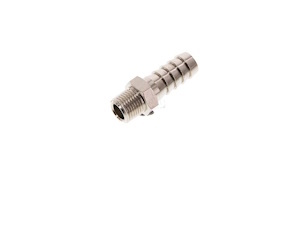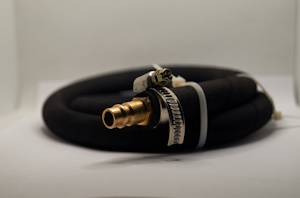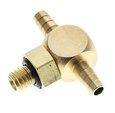Hose Barb Fittings

Figure 1: Brass hose barb fitting
Hose barb fittings provide a simple and secure way to connect hoses or tubing for fluid transfer applications. They are designed with a simple barb or ridge on one end that inserts into the hose, while the other end connects to another system component with, for example, a threaded connection. This article explores the design, installation, and applications of hose barbs.
Table of contents
- Design and installation
- Applications
- Selecting a hose barb fitting
- Hose barb size chart
- Leaks in hose barb fitting
- FAQs
View our online selection of hose barbs!
Design and installation
Design
Hose barb fittings are typically cylindrical, with one or multiple ridges (barbs). The barbs are designed to grip the inside of the hose, providing a secure and leak-resistant connection. The other end of the fitting is typically threaded. Hose barbs are generally used with soft side-type tubing, such as plastic or rubber tubing.
Hose clamps
Hose clamps are crucial in installing hose barb fittings, ensuring a secure and leak-free connection. They are designed to tighten around a hose, applying pressure and holding the hose onto the barb of the fitting. Using a hose clamp can greatly increase the pressure it can withstand, making it an essential component, especially in high-pressure applications.
Installation
To install a hose barb fitting, push the barbed end into the end of a hose. The barbs on the fitting make the connection tight and secure because they grip the inside of the hose. Use a clamp to secure the hose over the barb. This helps prevent the hose from coming off the fitting under pressure or with movement. The hose material fills the spaces between the barbs, which helps secure the fitting. To take the hose off the hose barb, cut the tubing with a knife so that it spreads away from the hose barbs. The fitting can usually be reused with a new hose.

Figure 2: A hose barb fitting secured with a hose clamp
Applications
Hose barb fittings are used in a variety of applications, including but not limited to:
- Plumbing systems: Hose barbs connect hoses or tubing in residential and commercial plumbing systems.
- Industrial applications: Hose barbs are widely used in manufacturing industries for pneumatic and hydraulic applications, carrying materials like air, gas, or fluids.
- Automotive: They're used in various automotive applications like coolant, fuel, or brake systems to connect hoses.
- Medical equipment: In medical fields, they are used in various devices for fluid transfer.
- Beverage industry: These fittings are used in beverage dispensing systems to connect hoses that carry liquids.
- Aquariums: To connect hoses in filtration, water change, or aeration systems.
- Gardening & irrigation: Hose barb fittings are often used in gardening tools and irrigation systems to connect hoses or tubing for water supply. These fittings are also vital in drip irrigation systems.
- Home brewing: They're also used in home brewing setups to connect tubing for transferring liquids.
However, a hose barb fitting is unsuitable for high-pressure applications, where the pressure could overcome the barb's ability to hold onto the tube. Hose barb fittings can be used for pneumatics, provided they can withstand the pressure from the pneumatic system.
Selecting a hose barb fitting
Sizing a hose barb fitting correctly ensures a tight, leak-free connection. Here are the steps you need to follow:
- Hose barb size: Use a ruler or caliper to measure the inside diameter of the hose that the fitting will install into. The barb's outer diameter (OD) should be similar to or slightly larger than the hose's inner diameter (ID) to ensure a snug fit. This is usually measured in inches or millimeters.
- Material: The hose's material can affect the barb's sizing. Some materials, like rubber or soft plastics, can stretch to accommodate a slightly larger barb. But harder or less flexible materials need a more exact match between the hose's ID and the barb's OD. Hose barb fittings come in various materials like plastic, stainless steel, nylon, and brass.
- Pressure rating: Ensure the hose and fitting can withstand the application’s operating pressure. Higher-pressure applications may require a more precise fit or a clamp to secure the connection.
Hose barb size chart
A hose barb size chart (Table 1) typically lists the hose ID (inside diameter), the barb OD (outside diameter), and the fitting size. The fitting size refers to the size of the other end of the barbed fitting that will connect to the device or another hose. For example, in a water system, this could be the size of the tap or valve where the hose will be attached.
Table 1: Barbed hose fitting size chart example
| Hose inner diameter (inch) | Barb outer diameter (inch) | Fitting size (inch) |
| 1/8 | 1/4 | 1/8 |
| 3/16 | 5/16 | 3/16 |
| 1/4 | 3/8 | 1/4 |
| 5/16 | 7/16 | 5/16 |
| 3/8 | 1/2 | 3/8 |
| 1/2 | 5/8 | 1/2 |
Note: The sizes can vary based on the manufacturer and specific fitting model. Always check the manufacturer's specifications when choosing a barbed hose fitting.
Leaks in hose barb fittings
Hose barb fittings can leak for multiple reasons.
- The tubing may split or crack on the barb. If the barb is not the correct size for the tubing or is too sharp, it can cause the tubing to split or crack over time due to stress. Similarly, if the barb is not properly inserted into the tubing or is over-stretched during installation, it can damage the tubing and cause leaks. To prevent this, ensure that the barb and tubing are appropriately matched in size and the fitting is done correctly.
- The size difference between the tubing and the hose barb. The barb may be too small for the inner diameter of the tubing, resulting in a poor seal.
- The hose barb fitting may be used in a high-pressure application that blows the fitting out of the tubing.
FAQs
What is a barbed hose fitting?
A barbed hose fitting is a connector used with flexible hoses or tubing. The fitting has a ridged or barbed end that grips the inside of the hose to hold it securely in place.
What are the different materials for barbed hose connectors?
Barbed hose fittings can be made from different materials, such as brass, stainless steel, plastic, and nylon, each offering different levels of durability, resistance, and suitability for various applications.
What are air hose barbed fittings?
Air hose barbed fittings are specifically designed for pneumatic systems. They have a barbed end that securely attaches to the inside of a pneumatic hose.
Where are garden hose barb fittings used?
Garden hose barb fittings are used in outdoor watering systems to connect hose sections or attach the hose to a water source, such as a tap or a pump.









